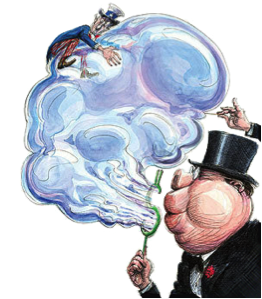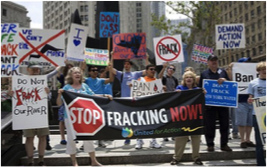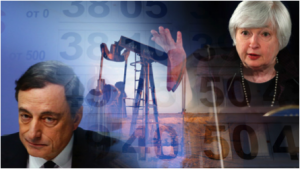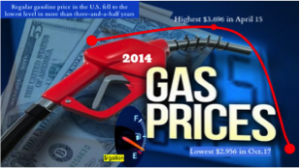The Battle between deflation and Inflation:
The most important insight into today’s markets is to understand the battle between deflations versus inflation. It’s important to realize that inflation always wins in the end. And busts always follow booms. The severity of the coming bust can be determined by looking at the scope, the magnitude, and the folly of the boom that it preceded. The Internet boom was minor compared with the silliness that followed in the real estate boom. As is experienced, the real estate bust was far worse than the one before.
 Today’s ongoing global financial boom is a madness of historic portions. The idea for more growth in GDP that successfully tens of trillions of newly printed dollars, euros, and yen can be invested, is the greatest financial nonsense ever witnessed since the time John Law used notes from the Royal Bank of France to create the first paper-money bubble in the early 1700s.
Today’s ongoing global financial boom is a madness of historic portions. The idea for more growth in GDP that successfully tens of trillions of newly printed dollars, euros, and yen can be invested, is the greatest financial nonsense ever witnessed since the time John Law used notes from the Royal Bank of France to create the first paper-money bubble in the early 1700s.
Money-value coordinates like GDP, productivity and stock market indexes are still adopted as the measures of economic performance, rather than life capital development, which is systemically attacked instead of advanced.
The correct approach of measuring GDP is to add together consumption, investment, government spending and net exports. The idea behind this is to measure total spending, as most goods produced are sold, and then you get an idea of how much productivity growth there’s been. What gets lost in all the reporting about numbers for stock markets, unemployment rates, and other economic data is the understanding that real wealth results from production of real goods, and not from the creation of money out of thin air. Central Banks can rig the numbers for a while by turning full blast the monetary spigot on, but the reality is that this is only papering over severe economic problems. Six years after the crisis of 2008, the economy still has not fully recovered, and in many aspects it is not much better than it was at the turn of this century.
Central banks can monetize everything, as they print over $1 trillion a year to buy bonds in masking the fact that the world is deep in a global dept. Leading to unprecedented asset bubbles, only to boost investors and consumers confidence, however they cannot print TRADE – the all important real driver of growth.
To further explain the impossibility why it is so hard to “grow your way out” of debt – based on US figures – look at the GDP as is reported to be $18 trillion a year – with $ 6 trillion coming from US federal and local government spending. This means that the private sector GDP – the part that pays the bills – only exists of $12 trillion. Total US debt – government, corporate and personal – stands now at $58 trillion. That’s almost five times the real economy that supports it. Assuming an annual interest rate of 2%, even if debt increases could be contained to 3% of GDP a year, the productive part of the economy would have a ‘real’ growth at 5% just to stay even. But no developed economy in the world is growing that fast.
At an interest rate of 3%, the annual interest on $58 trillion is $1.7 trillion. That’s slightly less than 10% of GDP. But it’s 14% – or one of every seven dollars – of the private sector economy. If the average interest rate were to rise to that level – sooner or later it will – it would take $3 trillion to service America’s debt – or one-quarter of private sector output, and that makes it impossible to ‘grow out of debt’ as income has  to increase faster than debt, which isn’t happen.
to increase faster than debt, which isn’t happen.
Bust
The bust, that just now is beginning, will dwarf all the others before it. As this problem appears, it multiplies, and spread to the point that trust in the dollar, euro and yen will disappear, none of the paper currency will protect savings, and people will hurry to what always has been trusted – that cannot be printed and never consumed; known as gold and silver that could start the next crisis. As almost none of it will be available for sale, make sure you own some of it now, and have that stored privately.
Don’t question whether inflation or deflation is the inevitable result of the central banks gone mad. There is no up and no down in this printing circus. There’s only a cycle. Money is printed. Then it’s invested. This imaginary capital is not yet being used for production, it is just cycling through the world’s economy.
The central bankers have the world fooled. As people should believe their paper currencies are sound, reinforcing the global financial system they’ve built, and making it reliable. But becoming wealthy by slicing each piece of the pie a little bit smaller, doesn’t work. It must have something real behind it – real savings, real work, real resources – or it is not worth the paper it is printed on. Otherwise it is nothing more than counterfeit money. And yet when Central Bankers engage in “quantitative easing” – in which they buy bonds with money created specifically for that purpose – it tries to get something for nothing. Without real savings or real money, and that’s plainly “counterfeited” as it is just as valuable like real money.
The Central Banks’ inflationary policies not only degrade the average citizen’s standard of living, they also believe in the “paradox of thrift.” Saving money may be good for an individual, they say, but it is bad for an economy. The more people save, the less they spend; the less they spend, the less consumer-led demand-driven growth there is. This is nonsense! There is no paradox. Saving is good for individuals and for groups. Economies do not become wealthier by spending; they become wealthier by saving. It is the process of saving – and investing in productive capital goods – that makes spending possible. Not the other way around. The more saving, the more capital the society has, which it can use to increase output and become richer. Then it can spend.
 An example: Take a look at the shale-oil industry. The ultra-low interest rates signaled to producers that capital was plentiful and cheap. So, why not use it to produce oil? The oil-frackers borrowed about $500 billion and are using the money to drill holes all over the place. They hired people too. It is suggested that almost all new created jobs since 2008 were related to the energy boom.
An example: Take a look at the shale-oil industry. The ultra-low interest rates signaled to producers that capital was plentiful and cheap. So, why not use it to produce oil? The oil-frackers borrowed about $500 billion and are using the money to drill holes all over the place. They hired people too. It is suggested that almost all new created jobs since 2008 were related to the energy boom.
Now the price of oil collapsed by manipulation, and under the pressure of too much new supply, undermining the industry’s profitability and calling into question the value of the reserves oil companies use as collateral for their debt. All of a sudden it looks like a lot of subprime energy debt is going bust. And that marks the end of the capital-spending boom that has been the highlight of the whole “recovery” myth.
 The Central Banks ‘unwillingly’ supported the oil price manipulation, as artificially created capital pushed down the price. If that is the case, expect oil prices staying down for a long period of time. Meanwhile, many producers will have been put out of business by the artificially low price. And many consumers will have been lured by the low prices into a position where they are vulnerable to higher prices. Central bankers will have damaged producers and consumers, and misdirected the entire world economy.
The Central Banks ‘unwillingly’ supported the oil price manipulation, as artificially created capital pushed down the price. If that is the case, expect oil prices staying down for a long period of time. Meanwhile, many producers will have been put out of business by the artificially low price. And many consumers will have been lured by the low prices into a position where they are vulnerable to higher prices. Central bankers will have damaged producers and consumers, and misdirected the entire world economy.
Biggest Bubble:
Since 1987, central banks – led by the Fed – have pumped up one bubble after another. The Final Bubble – the biggest bubble in credit itself – that still is expanding. Central banks will continue inflating it as long as they can. Then it will blow up.
“Be wary of stock market performance claims based on the last 30 years of experience; these years also  saw a huge increase in credit. Distrust any projection of performance based on those years. Be on your guard. You don’t want to be caught unaware and unprepared if it turns out this analyses is right – and the credit bubble finally explodes.”
saw a huge increase in credit. Distrust any projection of performance based on those years. Be on your guard. You don’t want to be caught unaware and unprepared if it turns out this analyses is right – and the credit bubble finally explodes.”
Remember counterfeited “money” cannot bring about real prosperity. There is nothing behind it – no savings, no resources and no real capital. But it can bring about bubbles. The biggest and most dangerous bubble today is in debt. Here the risk is exceptionally large. The debt bubble will pop in one of two ways: by inflation or defaults. The government may let energy companies default on their junk bonds. But when it comes to its own debt, most likely inflation will eventually reduce its value – perhaps to zero.
The question to ask is: When falls the game apart? Answer; when 30% of the corporate-bond market defaults, which absolutely will – when more than half of the shopping malls close as they absolutely will – when the oilfields go bust and the banks that lent the money have to close – that all is going to happen, what then?
For this answer, a few easy examples: With oil at $50 or less – and supply continuing to grow every month – what’s the future for the tens of billions of dollars that have been invested? What about real estate and car loans? Retailers in almost every category are finding it impossible to compete with Amazon and other online retailers. – Amazon – which doesn’t make money but nevertheless is valued at over $100 billion! These are prime example of how financial excesses can translate into real-world problems. Amazon couldn’t run its business at a loss if capital wasn’t free.
Deflation:
And when the game is falling apart deflation will roar its head. Deflation is a process most people are not accustomed to. Deflation and inflation don’t create or destroy resources. They simply move resources between people. Inflation takes resources out of creditors’ hands and gives them to debtors. Deflation shifts resources from debtors to creditors it is the reckoning. It’s creative destruction in action, as Schumpeter calls it.
Deflation is a process most people are not accustomed to. Deflation and inflation don’t create or destroy resources. They simply move resources between people. Inflation takes resources out of creditors’ hands and gives them to debtors. Deflation shifts resources from debtors to creditors it is the reckoning. It’s creative destruction in action, as Schumpeter calls it.
Central Banks and Governments will undertake everything to get 2% inflation. But if they cannot reach that, they’re in for a nasty surprise in the event they overshoot. In fact, to bring inflation too high above 2% too fast they might cause an upward spiral that eventually leads to hyperinflation.
 For governments and the financial system is “Deflation the real danger”. That’s why Central Bankers and governments fear deflation. Deflation makes paying back loans harder. Banks suffer when people owe them money. If those people can’t pay, the banks fail. Governments suffer because they owe more money than anyone else. If they don’t pay, government has a debt crisis and needs to shrink.
For governments and the financial system is “Deflation the real danger”. That’s why Central Bankers and governments fear deflation. Deflation makes paying back loans harder. Banks suffer when people owe them money. If those people can’t pay, the banks fail. Governments suffer because they owe more money than anyone else. If they don’t pay, government has a debt crisis and needs to shrink.
Central Banks suffer in a deflation too because as bankruptcies pile up, everyone shows up on their doorstep to cool their anger. In a deflation, prices are falling. But the physical property in the economy doesn’t go anywhere. At the end of even the worst deflation, the houses, businesses and cars or whatever still are there.
After the economy deleveraged and bankruptcies swept the country – prudent and capable people who saved their money could swoop in and scoop-up the businesses, cars, and houses for a cheap and use them profitably. Property in the world is limited. That’s why deflation brings these in the most capable hands. Doesn’t sound like such a bad thing when you think about it.
The world worried for decades about inflation – but deflation is still the real danger, because the economy is not in a normal cyclical recovery. The world is in a global depression; one that began in 2007 and for the time being will run on indefinitely. Central Bankers tried to treat this problem with monetary remedies, but these won’t work, as depressions are structural.
Monetary solutions and liquidity solutions are cyclical. They can help to change the business cycle. As credit gets too tight, the CBs loosen. Then things get a little hot and the CBs tighten. That’s the normal sine wave of business expansion and contraction as is seen since World War II. But now it is different, it is more like the Great Depression of the 1930s. That cannot be treated without structural changes – through changes in fiscal and regulatory policy.
In a depression people want to deleverage. They sell assets to get cash to pay off debts to reduce their balance sheet. What happens when assets are sold? It lowers the price. That puts the next one in distress. Now he also has to sell assets to deleverage his balance sheet and the process feeds on itself. And that is very, very difficult to control. It actually creates a state of mind where cash is more valuable.
During a period of deflation cash actually becomes more valuable in real terms. In fact, cash can be one of your best assets in a deflationary environment. But governments cannot tolerate deflation. There are several reasons. One of them is they haven’t figured out a way to tax it.
To explain this; you earn $100,000 and you get a 10 percent raise – that is a $10,000 raise – assume prices are constant. With a 10 percent increase in your standard of living the government takes half of it in the form of taxes, so the raise really is only 5 percent after tax.
In the opposite case where you have $100,000, you don’t get a raise and the prices drop 10 percent. That’s what deflation is. Now there is the same 10 percent increase in your standard of living because you’re not making any more money, but if everything you buy costs 10 percent less, you’re 10 percent better off.  However, here’s the difference. The government can’t tax that benefit to you. You get to keep the whole $10,000. That’s one reason governments hate deflation.
However, here’s the difference. The government can’t tax that benefit to you. You get to keep the whole $10,000. That’s one reason governments hate deflation.
The situation today is deflationary because we’re in a depression, but the government can’t tolerate deflation, they have to cause inflation. That’s why the money printing is going on. So, there is pressure on each side, inflation against deflation, money printing against depression – one pressure against the other.
In the beginning not much happens, but at some point it’s going to break. Now, it could break either way. It could break into inflation, or it could break into deflation. The assets that will do very well in deflation are things like cash and believe it or not, gold and silver. In the end inflation is more likely because the government wants it, but deflation is the state of the world today and that cannot be ruled out, for the time being, be prepared for that.
To be continued next week with: ‘Deflation against Inflation on a knife-edge’
Abundant Oil and Gas on the Planet
 Please Awake – Oil is NOT a ‘fossil fuel’… It is an ‘abiotic fuel’ – meaning a Self Regenerating Mineral. upply allnerating CompoundAwakeo keep the price and profits high for the cabal owned Oil Companies.on of the Crime Cabal tell yPl<There is sufficient oil and gas on the planet Earth to supply all markets for the next 200 years in abundance of oil and gas. But governments under instruction of the Organised Crime Cabal tell you different stories, in order to keep the price and profits high for the cabal owned Oil Companies.
Please Awake – Oil is NOT a ‘fossil fuel’… It is an ‘abiotic fuel’ – meaning a Self Regenerating Mineral. upply allnerating CompoundAwakeo keep the price and profits high for the cabal owned Oil Companies.on of the Crime Cabal tell yPl<There is sufficient oil and gas on the planet Earth to supply all markets for the next 200 years in abundance of oil and gas. But governments under instruction of the Organised Crime Cabal tell you different stories, in order to keep the price and profits high for the cabal owned Oil Companies.
Colonel L. Fletcher Proudly spills the beans about how oil was deliberately incorrectly classified as a fossil fuel, when in fact it is Abiotic. As such, it is replenished, naturally occurring source. Peak oil is a myth, or more accurately, a lie. Just like almost everything else the establishment ever told you.
Energy is a Non-Crisis.
Lindsey Williams, an ordained Baptist minister for 28 years, went to Alaska to serve as Chaplain on the pipeline, in the position with executive status at the Alyeska Pipeline Company. He was given access to information he documented in his eye-opening book, The Energy Non-Crisis. After numerous public speaking engagements in the western states, certain government officials and concerned individuals urged Mr Williams to put into print what he saw and heard, stating that they felt this information was vital to national security. Mr Williams firmly believes that whoever controls energy controls the economy.
Leave a Reply